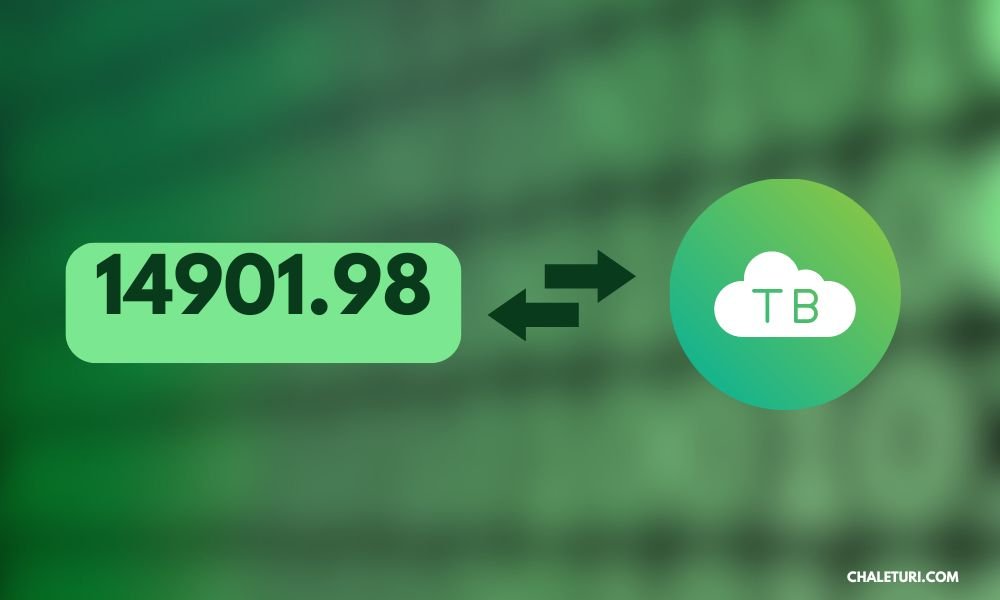In the modern world, driven by technology’s advancement, data is everything. It is indeed astonishing how information is transmitted and processed through our networks and devices in bulk, therefore, the way it is managed has to be efficient. Be it in IT or running a company or even in safeguarding personal information, one has to be versed with data management and more specifically the metrics. In this guide, we will outline the steps in changing 14901.98 to TB in gigabytes (GB) to terabytes (TB), which seem complicated but are of great importance in information organisation.
Understanding Data Units for Better Conversion
Hierarchy of Data Units
Units Any individual data unit is simply a building block for any digital data. Starting with the bottom of the data storage – the bytes, which is the lowest order of the hierarchy. These may be followed by kilobytes which comprises 1024 bytes. Then come the megabytes, which stand for 1024 kilobytes and the gigabytes which stand for 1024 megabytes. Therefore, lastly we arrive at the terabyte which is equal to 1024 gigabytes. In every one of these basic units, there is a considerable increase in the data capacity at every step up the hierarchy, thus conversion between these units is necessary for the correct interpretation of data.
Why 14901.98 is Significant in Conversions
It is easy to understand why the number 14901.98 may seem such an arbitrary number, but speaking about the conversion of the data – every decimal point counts. When you are working with figures that have to be very precise, especially in sectors such as engineering, updating the contents of data is very important. This ensures that you do not lose track of how to convert 14901.98 GB to TB and the whole essence of data becomes intact making it easier to manage data more constructively.
Mastering the Conversion Process
Formula for Converting GB to TB
The conversion of gigabytes to terabytes boils down to a rather fundamental principle. When converting gb to tb, simply use a divisor of 1,024. This simple usage of the formula is vital to everyone working with loads of data because it allows easy conversion of data from one unit to another.
Method: Divide by 1,024
The method can also be carried out by taking the gigabyte value, in this case 14901.98, and simply dividing by 1,024. For example another division of 14901.98 gb by 1,024 gives you the value of terabytes. This division makes it easier for you when it comes to handling data management tasks. There is no way you can go wrong with this calculation with respect to data conversions.
Example Calculation: 14901.98 GB to TB
Let us practise the given method. In this instance when dividing 14901.98 GB by 1,024, one obtains almost 14.557 TB. In this specific example, it is apparent that such simple mathematical operations of this nature can bear a clearer picture of the entire data management strategies involving storage.
Importance of Accuracy in Data Conversions
Data conversions require accuracy in all aspects. Exemplifying such errors, it is evident that data reporting and management would encompass evidence encompassing data storage cost management and system operation performance among others. Every time precision is maintained in your conversions, data protection is assured as well as good decision making is encouraged.
Exploring Practical Applications of Data Conversion
Data Management and Storage Planning
Planning and performing data conversion is essential while designing and implementing any data management practice. First, data unit conversion is very important for enhancing storage space and ensuring data availability when it comes to storage from corporate databases to cloud storage systems.
Corporate Databases and Cloud Storage
In the modern corporate setup, the data storage system needs to be both extensible and durable. When data could be represented in different units such as KB, MB, GB, TB or any other unit, the end users are able to manage the storage systems that the organisations provide even as the corporate expansion strategies are optimally implemented.
Backup Systems and Real-World Examples
Data backup is one of the main aspects of any data management. Foresight also relates to storage requirements. For calculating disk storage requirements, it is suggested to convert terabytes, for example, and more precise expectations can be developed for disparity systems, which now augment and reinforce protection over the data to avoid damage or loss.
Media and Entertainment Industry
The processes involved in data conversion are regarded as important factors in the media and entertainment industries. Since projects always involve high definition content that consumes a lot of storage, data unit conversion helps in achieving the management of the project in the most efficient ways.
High-Definition Content Storage
Storing HD Content takes up a lot of resources. Media Professionals are able to estimate their storage requirements accurately by translating gigabytes into terabytes thereby avoiding bottlenecks and ensuring that content deliverables are met smoothly.
Planning for Project Storage Needs
Effective project planning in the media industry is aided by proper data conversion allowing teams to manage their resources efficiently within timelines whilst not getting short changed on quality or performance.
Addressing Challenges in Conversion and Storage
Data Transfer Speeds and Infrastructure
Data migration is only one aspect of the entire process. Making sure that your infrastructure is able to facilitate high speeds of data transfer is equally important given the presence of large volume of data.
Impact of Slow Transfer Rates
Indeed, slow data transfer rates result in wastage of efforts and time and worse, when opportunities are missed. If such problems are taken care of, organisations will be able to make their operations more effective, and the success and satisfaction of users more tangible.
Need for Robust Storage Solutions
When large scale data is to be converted, strong storage are needed. With proper infrastructure in place, organisations will improve on their management of data and thus engender growth and progress.
Data Security and Management
Without a doubt, data security is a matter of consideration for almost all professionals regardless of the type of data they tend to work with, especially large holders. In work such as this, knowing how to change data units to appropriate forms is the least embarrassing since it is part of security application methods that guard kept information from being accessed where it’s not supposed to be or lost.
Risks of Handling Large Datasets
Managing extensive databases poses risks including loss of data and loss of system. If such a focus is placed on data protection and appropriate conversion norms are embraced, these aggressions can be minimised, alleviating the burden to the organisation and its name.
Implementing Effective Security Measures
Security safeguards incorporate protection of data securely and also the physical aspects. Such additional safeguards on data management will minimise the risks posed on the data without violating any of the legal procedures of conducting business.
Tools for Data Conversion Mastery
Online Calculators and Software Solutions
There are a number of multiplication units that help to convert different types of data. These resources provide simpler ways of trying to effect such a conversion enabling both professionals and amateurs in the work.
User-Friendly Conversion Tools
Data conversion tools that are easy to use enhance the turn around time in doing different conversion activities as the user is taken through the whole process until the goal is achieved. These resources are essential for an organisation that wishes to enhance its data management processes.
Integration with Data Management Systems
Numerous tools for conversion enhance established data management practices as their use broadens the scope of the current processes. Organizations can improve their data processes by reducing the use of manual elements in the execution of these processes through the use of these integrations.
Resources for Learning Data Conversions
Self-education on data conversions is a worthwhile undertaking, which gives the abilities necessary for success in a career. There are many different opportunities, such as online classes or books on data conversion depending on how and what level one wants to learn.
Educational Guides and Courses
Educational resources provide proper and deep understanding of data conversions enabling learners to create the solutions which are complex data problems. These guides and courses are to provide outlook and change the slide to better data literacy.
Importance of Mastering Conversions
Learning how to convert data is an important skill for all those involved in the management of data. It is necessary to emphasize these fundamental rules that make born-centric managers imbibe their decision-making, data handling processes, and even drive the business forward.
The Future of Data Storage and Conversion
Emerging Technologies and Data Growth
The evolution of these various technologies as well as the increase in data is bound to change the data environment. Companies can be at the front line of innovations by being aware of such developments.
Quantum Computing and AI Implications
The repercussions of quantum computing and artificial intelligence advancements are said to change the face of how information is stored as both of them pose great computing power and data analysis expertise. Appreciation of such technologies will help companies reshape their current operating models in readiness for the volatile environment.
Future Data Unit Measurements
The growth in data quantities will likely influence the unit of measure and how it is understood in the future. Companies have to keep abreast with these developments to remain effective and be able to respond to requirements such as new ways of doing things when they arise.
Impact on Business and Personal Data Management
Within the transformed data storage, the businesses and personal data management will be affected positively or negatively. So, small and large organizations and individuals have to get ready for these threats in order to control their data which would help them continue forward without any danger.
Conclusion
To conclude, it is important to note that knowing how to accurately transform 14901.98 GB to TB is relevant in this age of information. When one learns the art of the conversion of the data, one can make the practice of data management more efficient, better the decision making, and ultimately impact positively the organization. Make use of all the tools and resources you have to improve your knowledge and become a practitioner of the profession so that you will be prepared for the fight in the field, which is constantly changing with data.
FAQs
How do I convert gigabytes to terabytes?
The conversion of gigabytes to terabytes is performed by dividing the figure expressed in gigabytes by 1024. This further simplifies how you manage your data saving time and complexity within your organization.
Why is this conversion important for businesses?
It is very important for businesses to accurately convert data units to avoid wastage of resources in data management, ensure proper space allocation, and enhance effective decision making.
What are common challenges in data conversion?
Some of such challenges include accuracy, dealing with bulk data, and providing appropriate tools for data conversion that are easy to interface with existing data management systems. These are some of the issues that ought to be resolved to promote the practice of data conversion.
Which industries benefit most from these conversions?
The sectors that require data conversion IT, media and entertainment need this more as data is the ‘fuel’ that enhances their efficiency and competitiveness in the market.




